1 of 20
Download to read offline
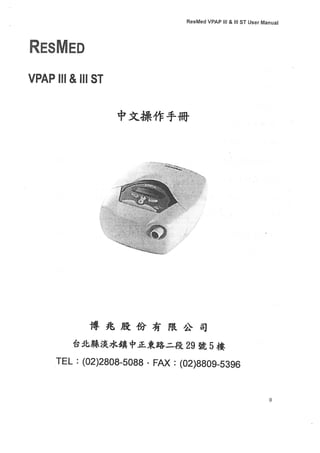

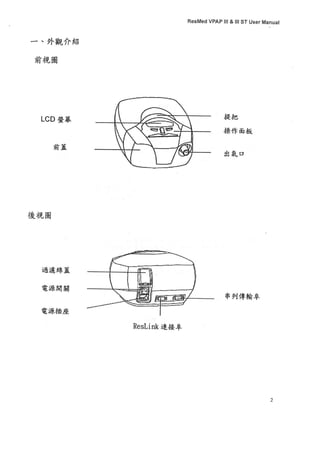




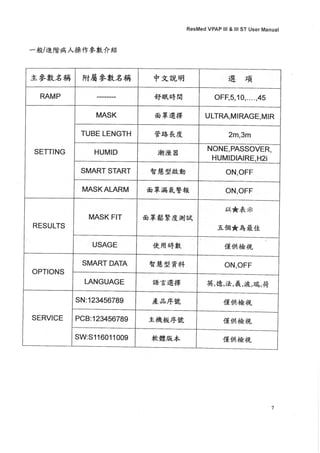


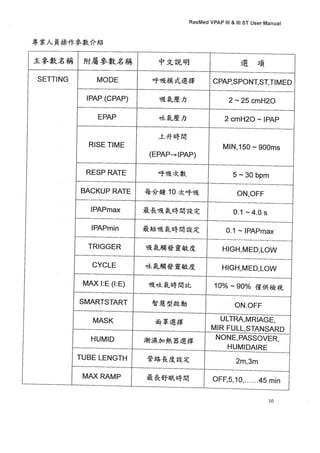
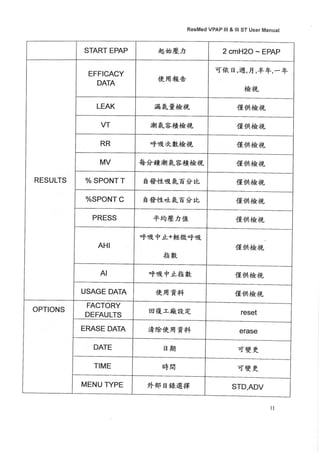
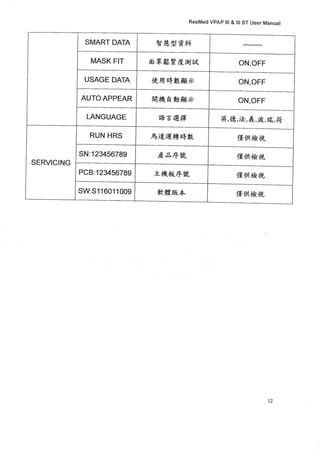
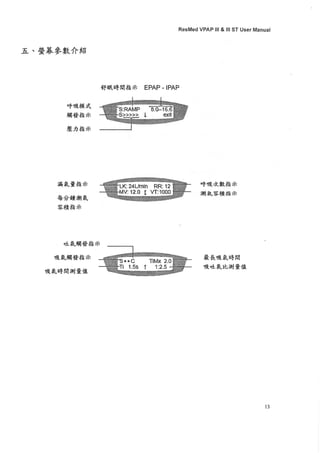
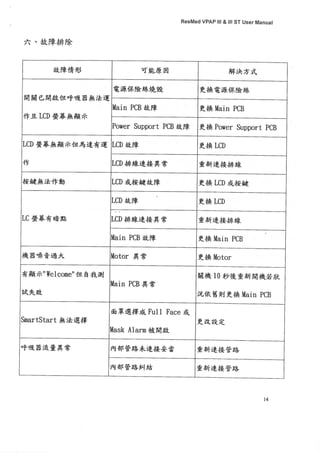



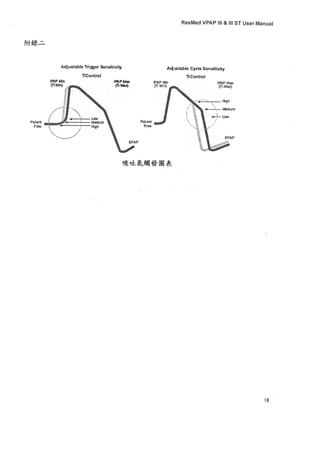
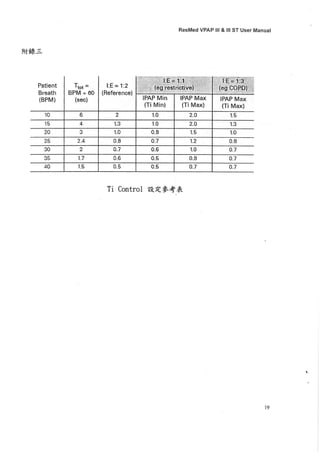
Ad
Recommended
Vpap iii st-a中文操作手冊
Vpap iii st-a中文操作手冊其輝 林
?
vpap? iii st-a 是一種非侵入性通氣設備,主要用於治療成人呼吸功能不全和阻塞性睡眠呼吸暫停。使用前需確認患者是否有任何相關醫療狀況,並遵循設置和操作步驟以確保有效治療。設備配備多項功能,如面罩試戴、智能啟動,以及多種設置選項,以便優化使用體驗。咳痰机简易操作卡
咳痰机简易操作卡Yujung
?
该文档提供了对于咳痰机的操作手册,包括设备的组装、吸吐气压力的设置及使用频率等详细步骤。此外,还给出了针对初用者和不同患者的建议设置。最后,文档描述了清洗和消毒管路及相关配件的要求。TEX - LUD 151. Muddy Creek
TEX - LUD 151. Muddy CreekStripovizijacom
?
The document discusses the benefits of exercise for mental health. It states that regular exercise can help reduce anxiety and depression and improve mood and cognitive function. Exercise causes chemical changes in the brain that may help alleviate symptoms of mental illness.0132. Jezero Le?Inara
0132. Jezero Le?InaraTompa *
?
The document outlines the achievements and impact of George Washington, emphasizing his role as a leader during the U.S. independence movement and his tenure as the first president. It highlights his views against slavery and his enduring influence on national unity.Veliki Blek L 069 - Relikvija iz dinastije Ming
Veliki Blek L 069 - Relikvija iz dinastije MingStripovizijaStripovi
?
Veliki Blek L 069 - Relikvija iz dinastije MingZagor vc b 023 - Alahova ruka - Molok (01)
Zagor vc b 023 - Alahova ruka - Molok (01)StripovizijaStripovi
?
The document discusses the history and development of the city of New York over several centuries. It describes how the city began as a small Dutch settlement called New Amsterdam in the 1600s and gradually grew into a major global economic and cultural center. The document outlines some of the key events and periods in New York's history that contributed to its transformation into one of the largest and most influential cities in the world.Zagor sd 046 - Obojeni ?ovjek
Zagor sd 046 - Obojeni ?ovjekStripovizijacom
?
The document discusses the benefits of exercise for mental health. Regular physical activity can help reduce anxiety and depression and improve mood and cognitive functioning. Exercise has also been shown to increase gray matter volume in the brain and reduce risks for conditions like Alzheimer's disease and dementia.Resuelve el misterio 18 el misterio de las perlas autenticasdalilah clipatra
?
El documento habla sobre la importancia de la privacidad y la seguridad en línea. Explica que los usuarios deben tomar medidas para proteger su información personal en Internet, como usar contrase?as seguras y actualizadas, y estar atentos al phishing. También recomienda configurar las preferencias de privacidad en las redes sociales y aplicaciones para compartir solo con amigos cercanos.Zagor Ludens Almanah 011 - ?udovi?te crnog mjeseca
Zagor Ludens Almanah 011 - ?udovi?te crnog mjesecaStripovizijacom
?
Zagor Ludens Almanah 011 - ?udovi?te crnog mjesecaZagor extra 280 sedam moci
Zagor extra 280 sedam mociStripovizijacom
?
The document discusses the benefits of exercise for mental health. Regular physical activity can help reduce anxiety and depression and improve mood and cognitive functioning. Exercise has also been shown to boost self-esteem and can serve as a healthy way to manage stress.Fce use of_english_1_teacher_s_book
Fce use of_english_1_teacher_s_bookmihaela gula
?
The document discusses the benefits of exercise for mental health. Regular physical activity can help reduce anxiety and depression and improve mood and cognitive functioning. Exercise causes chemical changes in the brain that may help protect against mental illness and improve symptoms.ZS - 0379 - PSDZ - LUTAJUCI VITEZ
ZS - 0379 - PSDZ - LUTAJUCI VITEZStripovizijacom
?
The document discusses the benefits of exercise for both physical and mental health. It notes that regular exercise can reduce the risk of diseases like heart disease and diabetes, improve mood, and reduce feelings of stress and anxiety. The document recommends that adults get at least 150 minutes of moderate exercise or 75 minutes of vigorous exercise per week to gain these benefits.The difficult extubation
The difficult extubationwanted1361
?
The document discusses the top five post-extubation emergencies: laryngospasm, laryngeal stridor, acute hypoxemia, acute respiratory failure, and neurologic pathology. It provides definitions and discusses how to potentially predict and treat each emergency. Key points include that extubations should not be treated as routine, extensive assessment is important, and having difficult intubation supplies available is critical in case re-intubation is needed. The document emphasizes being prepared for potential post-extubation complications.9710 Icu
9710 Icu軒名 林
?
The document discusses criteria for determining when a patient can be safely removed from mechanical ventilation, including assessments of respiratory, cardiovascular and mental status. It describes methods used to identify patients who can tolerate a spontaneous breathing trial, such as the rapid shallow breathing index. The document also outlines protocols for conducting spontaneous breathing trials through a ventilator or T-piece and managing issues that could arise like respiratory failure, low cardiac output, or laryngeal edema.More Related Content
What's hot (20)
Zagor vc b 023 - Alahova ruka - Molok (01)
Zagor vc b 023 - Alahova ruka - Molok (01)StripovizijaStripovi
?
The document discusses the history and development of the city of New York over several centuries. It describes how the city began as a small Dutch settlement called New Amsterdam in the 1600s and gradually grew into a major global economic and cultural center. The document outlines some of the key events and periods in New York's history that contributed to its transformation into one of the largest and most influential cities in the world.Zagor sd 046 - Obojeni ?ovjek
Zagor sd 046 - Obojeni ?ovjekStripovizijacom
?
The document discusses the benefits of exercise for mental health. Regular physical activity can help reduce anxiety and depression and improve mood and cognitive functioning. Exercise has also been shown to increase gray matter volume in the brain and reduce risks for conditions like Alzheimer's disease and dementia.Resuelve el misterio 18 el misterio de las perlas autenticasdalilah clipatra
?
El documento habla sobre la importancia de la privacidad y la seguridad en línea. Explica que los usuarios deben tomar medidas para proteger su información personal en Internet, como usar contrase?as seguras y actualizadas, y estar atentos al phishing. También recomienda configurar las preferencias de privacidad en las redes sociales y aplicaciones para compartir solo con amigos cercanos.Zagor Ludens Almanah 011 - ?udovi?te crnog mjeseca
Zagor Ludens Almanah 011 - ?udovi?te crnog mjesecaStripovizijacom
?
Zagor Ludens Almanah 011 - ?udovi?te crnog mjesecaZagor extra 280 sedam moci
Zagor extra 280 sedam mociStripovizijacom
?
The document discusses the benefits of exercise for mental health. Regular physical activity can help reduce anxiety and depression and improve mood and cognitive functioning. Exercise has also been shown to boost self-esteem and can serve as a healthy way to manage stress.Fce use of_english_1_teacher_s_book
Fce use of_english_1_teacher_s_bookmihaela gula
?
The document discusses the benefits of exercise for mental health. Regular physical activity can help reduce anxiety and depression and improve mood and cognitive functioning. Exercise causes chemical changes in the brain that may help protect against mental illness and improve symptoms.ZS - 0379 - PSDZ - LUTAJUCI VITEZ
ZS - 0379 - PSDZ - LUTAJUCI VITEZStripovizijacom
?
The document discusses the benefits of exercise for both physical and mental health. It notes that regular exercise can reduce the risk of diseases like heart disease and diabetes, improve mood, and reduce feelings of stress and anxiety. The document recommends that adults get at least 150 minutes of moderate exercise or 75 minutes of vigorous exercise per week to gain these benefits.Viewers also liked (7)
The difficult extubation
The difficult extubationwanted1361
?
The document discusses the top five post-extubation emergencies: laryngospasm, laryngeal stridor, acute hypoxemia, acute respiratory failure, and neurologic pathology. It provides definitions and discusses how to potentially predict and treat each emergency. Key points include that extubations should not be treated as routine, extensive assessment is important, and having difficult intubation supplies available is critical in case re-intubation is needed. The document emphasizes being prepared for potential post-extubation complications.9710 Icu
9710 Icu軒名 林
?
The document discusses criteria for determining when a patient can be safely removed from mechanical ventilation, including assessments of respiratory, cardiovascular and mental status. It describes methods used to identify patients who can tolerate a spontaneous breathing trial, such as the rapid shallow breathing index. The document also outlines protocols for conducting spontaneous breathing trials through a ventilator or T-piece and managing issues that could arise like respiratory failure, low cardiac output, or laryngeal edema.Post extubation stridor
Post extubation stridorAndrew Ferguson
?
The document discusses post-extubation stridor, which is upper airway obstruction that can occur after a patient is extubated from a ventilator. It defines post-extubation stridor and reviews risk factors such as duration of intubation and cuff pressures. The cuff leak test is presented as a way to identify patients at risk. Studies are reviewed showing steroids given before extubation can reduce the risk of stridor. Clinically, it recommends identifying at-risk patients, performing the cuff leak test, and considering steroid treatment for high-risk patients before extubation.Extubation problems and its management
Extubation problems and its managementDr Kumar
?
Dr. Kumar presented on extubation problems and their management. Some key points:
1. Tracheal extubation requires careful planning and preparation to prevent complications like laryngospasm, laryngeal edema, and pulmonary aspiration.
2. Patients should generally be extubated awake to allow for airway protection, but deep extubation may be considered to reduce cardiovascular stimulation.
3. Potential problems include mechanical issues removing the tube, cardiovascular changes, respiratory complications, and airway obstruction. Management depends on the specific issue but may include medications, positioning, or alternative extubation techniques.
4. Careful evaluation of each patient's risk factors and planning is necessary to safely perform extubation and preventEndotracheal intubation extubation
Endotracheal intubation extubationDang Thanh Tuan
?
This document summarizes the indications, procedures, equipment, and complications related to endotracheal intubation and extubation. It describes the anatomy of the upper airway and indications for intubation such as respiratory failure, airway obstruction, or the need for positive pressure ventilation. The document outlines the procedures and equipment used for oral and nasal intubation, including laryngoscopes, endotracheal tubes, and positioning. Potential complications of intubation and extubation are also summarized such as infection, trauma, aspiration, and laryngeal injury.Nursing Care of Ventilated Patient
Nursing Care of Ventilated PatientJaber Nami
?
The document outlines the use and management of mechanical ventilation, including its definition, indications, modes, adjustments, complications, and nursing management strategies. It emphasizes the need for careful adjustments to ensure patient comfort and minimize complications such as decreased cardiac output and barotrauma. Furthermore, it highlights the importance of monitoring patients for complications and providing supportive care, including nutrition and infection prevention.Ventilator Alarm Checklist
Ventilator Alarm ChecklistKane Guthrie
?
This document provides checklists for responding to common ventilator alarms and troubleshooting a crashing ventilated patient. For high airway pressures, possible causes include a tube in the right main bronchus, bronchospasm, mucous plugs, and pneumothorax. For low minute volumes, possible causes are an endotracheal tube cuff deflation allowing an air leak or chest wounds allowing air to escape. The checklist for a crashing ventilated patient follows the acronym D.O.P.E.S. to identify potential problems, then D.O.T.T.S. to address them, such as checking tube position or ventilator settings.Ad
More from Yujung (17)
Prisma25 st
Prisma25 stYujung
?
prisma 25st呼吸器具有德國工藝和多種先進技術,提供高效的睡眠呼吸治療。其特點包括超靜音運作、液晶觸控介面、以及多種調整功能,支援多種通氣模式及自我檢測。呼吸器的設計適用於COPD及其他相關呼吸困難症狀,提供靈活的治療選擇和高安全性。宜寧一零六年度評鑑簡報 範本簡易版
宜寧一零六年度評鑑簡報 範本簡易版Yujung
?
本文件是宜宁居家护理所106年度评鉴简报,包括单位介绍、评鉴项目准备和各项行政管理措施。简报强调服务流程、人员培训、案例管理和健康安全等内容,以确保提供高质量的居家护理服务。文件还提供创新改革措施和政策配合的相关信息。尝别驳别苍诲补颈谤中文操作手册
尝别驳别苍诲补颈谤中文操作手册Yujung
?
本操作手册详细介绍了居家型呼吸机尝别驳别苍诲补颈谤的使用方法及操作面板功能,包括开机步骤、通气及暂停通气操作,以及处理常见警报的指南。该设备具有压力与容积双重控制功能,并设有安全保护措施以确保病人使用的舒适与安全。手册还提供了制造商的联系方式及设备维护信息。尝迟惫950中文操作手册
尝迟惫950中文操作手册Yujung
?
本文档详细说明了 LTV 系列呼吸机的操作,包括开关机、模式切换、参数设置及警报处理等功能。重点介绍了各个控制面板的功能键及其设置方法,如呼吸模式的选择和警报设置。用户需遵循步骤进行操作,以确保设备正常运作和病患安全。础30中文操作手册
础30中文操作手册Yujung
?
本手冊適用於Philips Respironics的BIPAP A30呼吸器,為居家醫療提供重要操作指導,包括功能設置和警報管理。手冊詳細說明了用戶能否變更設定的權限、設備的使用注意事項及安全警示,強調使用者需在專業人員指導下操作。使用者在開始使用設備前必須仔細閱讀並理解手冊內容,以確保病人的安全與治療效果。Elisee 150
Elisee 150Yujung
?
本文件介绍了Elisee 150呼吸器的特性、规范和操作说明,包括独特的供气系统、各种呼吸模式和便利的维护检测功能。该呼吸器适用于成人和儿童,提供多种警报和监测功能。其设计旨在提供高效的呼吸支持,同时简化设置和操作过程。罢产颈谤诲呼吸器介绍
罢产颈谤诲呼吸器介绍Yujung
?
t-bird 呼吸器是一种先进的呼吸器系统,旨在提供无缝和移动式的呼吸支持,适用于多种医疗场合。它采用革命性的涡轮技术,具有模块化设计、内建电池和易于操作的控制面板,降低了成本和复杂度。该装置可支持成人和儿童使用,并在短暂停电时提供紧急电源供气。笔尝痴100&补尘辫;102呼吸器介绍
笔尝痴100&补尘辫;102呼吸器介绍Yujung
?
文档介绍了呼吸器及电力系统,重点在于电池电力测试和显示的电压与电量的换算方法。通过对电池状态的判断,使用者可以了解可使用的时长。同时,还涉及了呼吸器的流速设置和管路装置的标准配置。New Synchrony呼吸器介紹
New Synchrony呼吸器介紹Yujung
?
该文档详细介绍了一种呼吸器的结构、操作步骤及设置参数,包括电源接入、面罩选择和监控病人呼吸参数等。还特别强调了清洁与保养的注意事项以确保设备的正常使用。通过各种操作模式和警报设置,使用者可以根据病人的具体需求进行精细调节。人工急救甦醒球
人工急救甦醒球Yujung
?
人工呼吸急救甦醒器用于心肺复苏和呼吸辅助,包含自充气甦醒球和单向阀等组件。其设计标准由美国心脏学会和国际标准组织规定,以确保氧气浓度和潮气容积满足急救需求。操作时需注意病人的呼吸道通畅,并根据病人情况选择合适的甦醒器及其材料。雾气治疗介绍
雾气治疗介绍Yujung
?
本文件介绍了雾气治疗的基本概念、装置类型及其疗效,阐述了气雾粒子的应用范围和临床目标,包括改善呼吸道治疗效果。文件细致列出了不同的雾气设备(如小容量和大容量喷雾器、定量吸入器等)的优缺点,以及使用中可能面临的风险和注意事项,强调了正确使用气雾治疗设备的重要性。空气过滤介绍简报
空气过滤介绍简报Yujung
?
本文件介绍了空气过滤器和防护口罩的基本知识,包括过滤器的种类、测试标准和选择合适过滤器的指南。强调使用过滤器能预防感染、保护病人及医护人员。文中详细解释了不同过滤器的过滤效率及其对医疗环境的重要性。居家呼吸照护网站网页设计
居家呼吸照护网站网页设计Yujung
?
宜寧居家护理所由专业医疗团队提供居家呼吸照护服务,强调以病患需求為导向的专业评估与健康照护。网站和部落格设计旨在提升与病患及家属的互动,并提供全面的资源与资讯。护理所期望透过部落格整合各类护理资讯,增强服务品质及教育资源。Ad